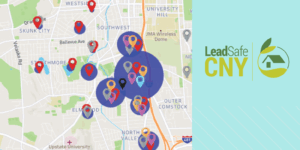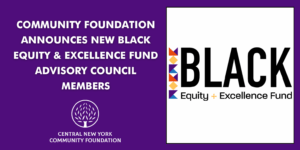The Central New York Community Foundation has released a new policy paper entitled, The Social & Economic Impacts of Supporting Black-Led Organizations: A Rationale for the Black Equity & Excellence Fund. The paper outlines why we are investing intentionally and publicly in the support and celebration of Black members of our community. Click the button below to view the paper and scroll down to view a message from our President & CEO.
View Policy PaperA Message from our President & CEO
No matter where you come from, what you look like, or how much money your family has, everyone should have the opportunity to learn, grow, and thrive. However, opportunity in America has traditionally depended on who you are and where you come from. Policies, practices, and beliefs—rooted in history and still affecting people today—continue to prevent people in the Black, Latino, Native American and Asian American/Pacific Islander communities from fulfilling their potential.
A policy paper recently published by the Central New York Community Foundation demonstrates this through data. In Onondaga County, Black median household wages are 48% of that of White households. The percentage of Black third graders reading on grade level is a third of that of White students. Black children are more than three times more likely to live in poverty than White children. Across the nation, the life expectancy of Black people is 7% lower than of White people and White infant mortality is 70% less than it is for Black infants. The data speaks for itself.
The concentration of Black people living in poverty and in neighborhoods that contribute to poor health in Syracuse is not an accident, nor is it an outcome of our free market economy. It is the result of decades of policies pertaining to residential development, lending, and transportation. Clearly, until these inequities are resolved, structural racism will continue to undermine our efforts to improve literacy and education rates, increase positive health outcomes and break down the detrimental cycle of generational poverty. Communities that invest in efforts to end structural racism will see a significant and broadly based return on investment in the form of higher educational levels, higher household incomes and lower levels of poverty.
That is why one year ago we committed to invest $1 million in the establishment of the Black Equity & Excellence Fund, which supports community-based projects for the Black community of Central New York. So far, the fund’s all-Black advisory council has distributed nearly $550,000 in grants to programs that help build equity.
According to the policy paper, Black-led nonprofits find themselves with net assets up to 76% smaller than those of their White counterparts. And while Black people make up 14.2% of the population nationally, Black businesses make up only 2.2% of all businesses. These businesses often lack access to credit and investment capital, stunting their growth and holding back community and economic development.
By supporting organizations whose boards and staff leadership are primarily Black, we seek to reverse this pattern of historic underinvestment and support lasting and positive change for the Black community.
Visit http://www.cnycf.org/EquityPaper to view the full policy paper entitled, The Social & Economic Impacts of Supporting Black–Led Organizations: A Rationale for the Black Equity & Excellence Fund.
To support or learn more about the Black Equity & Excellence Fund, visit cnycf.org/equity.
Peter A. Dunn
President & CEO
Central New York Community Foundation









